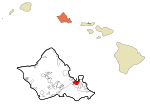Windward Mall
Windward Mall is an enclosed shopping center located in Kāneʻohe, Hawaiʻi, anchored by Macy's, and Regal Cinemas. The 530,000-square-foot (49,000 m2) mall, owned by Kamehameha Schools, was managed by General Growth Properties until 2011 when General Growth Properties and Jones Lang LaSalle entered an agreement to transfer managership to Jones Lang LaSalle.The mall underwent a significant $23 million renovation in 2006 to improve the interior and add new retail tenants.On April 15, 2019, it was announced that Sears would be closing on April 30, 2019. The former Sears space will soon be replaced with a new Target store, which is slated to open in 2022.On January 4, 2023, it was announced that Macy's would shutter.
Excerpt from the Wikipedia article Windward Mall (License: CC BY-SA 3.0, Authors).Windward Mall
Kamehameha Highway, Kaneohe
Geographical coordinates (GPS) Address External links Nearby Places Show on map
Geographical coordinates (GPS)
| Latitude | Longitude |
|---|---|
| N 21.4205 ° | E -157.8046 ° |
Address
Windward Mall
Kamehameha Highway 46-056
96744 Kaneohe
Hawaii, United States
Open on Google Maps







